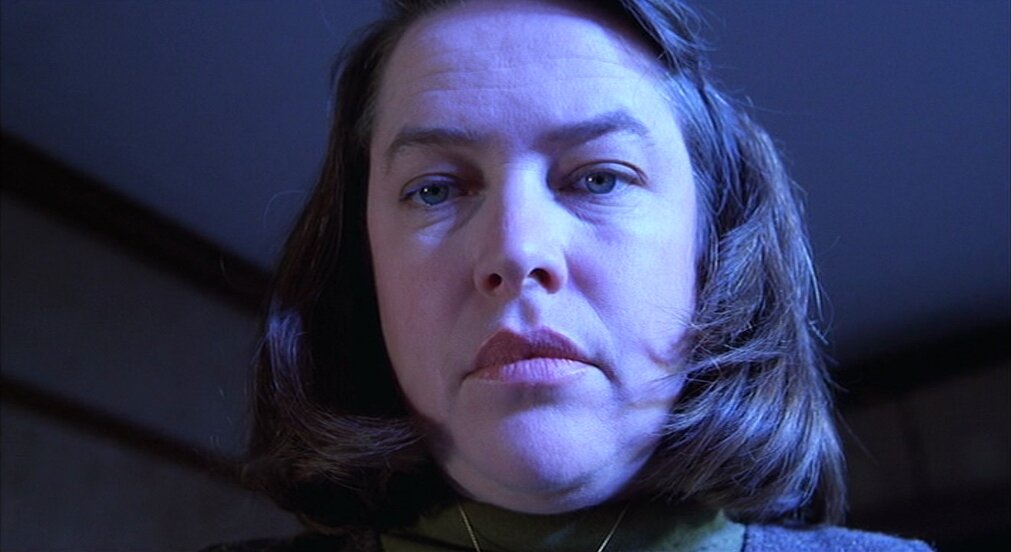Misery (dir. Rob Reiner, 1990) - Review
Download the Misery screenplay for personal, private use.
For many people, 2020 inspired a newfound aversion to home confinement and middle-aged white women. Misery prominently features both.
Neither of these horrors seem less relevant as the new year dawns; indeed, the movie’s third major theme of substance abuse- fuelled by Stephen King's acknowledgement that Annie Wilkes represents his alcohol and drug addiction- is likely to become only more relatable with further lockdowns looming.
“Annie was coke, Annie was booze, and I decided I was tired of being Annie's pet writer,” remembered King in 2000’s On Writing. Perhaps due to the angst of its origins, the story of a celebrity author tormented by the pressures of his readership- embodied by a frumpy nurse who traps him in her home after a crippling car accident- benefits from a surprising level of nuance. There are no supernatural forces at work, no chainsaw-wielding psychopaths; William Goldman’s screenplay adaptation highlights the way in which the human psyche can create monsters from the mundane, provoking a titillating and expertly balanced blend of revulsion and sympathy.
Misery is a film of oppositions: its horror derives from extremes brought into unnatural, protracted intimacy. The psychologically fraught pairing of Paul Sheldon (James Caan) and Annie Wilkes, his "number one fan” (Kathy Bates), as well as the schism between Annie’s outwardly harmless, motherly persona and the murderous sadist within, are echoed in visual polarities. The empty whiteness of snow outdoors and blank pages in the typewriter are contrasted with fleshy shots of the duo in their domestic prison, with the abundance of printed word in Paul’s manuscripts and the newspaper clippings which reveal Annie as a ‘monster’. The overall effect suggests two worlds: a familiar, earthly realm- Paul’s glamorous, cosmopolitan life as a bestselling author- and the hell into which he is plunged in Annie’s isolated cabin.
Whilst Goldman and director Rob Reiner softened the novel’s more shocking elements, the film retains a keen interest in the primal, uncivilised impulses to which, it suggests, modern citizens are more than capable of reverting under the right conditions. Paul and Annie’s relationship charts an unsettling course from benevolent mother-son territory to a taboo-trampling, chintzy Oedipal spectacular.
The film’s continued appeal as a claustrophobic two-hander derives from a production process which compelled the actors into a level of genuine discomfort, approaching the emotional basis on which King wrote the novel. Goldman’s memoirs listed over a dozen actors who turned down the role of Paul Sheldon, from Jack Nicholson and Dustin Hoffman to Robert De Niro and Bruce Willis (who would eventually shoulder it in a 2015 Broadway adaptation). Warren Beatty summed up the widespread aversion by opining that the ankle-breaking scene made Sheldon “a loser for the rest of the film”: Annie’s fictional emasculation of Paul translated all too readily into the emasculation of the actor playing him, since, in Goldman’s view, Annie overshadowed him so much as a character. The fear proved an apt one when Kathy Bates- a hitherto obscure theatre actress- carried off the Best Actress Oscar in 1990, becoming the first woman to win one in a horror film.
Kathy Bates’ performance as Annie peels back the layers of familiarity around the conventionally benevolent image of womanhood. Goldman and Reiner took care to create a sympathetic portrayal of Annie as a conflicting blend of different feminine elements, keeping the audience, like Paul, on tenterhooks as her character veers from pathetic to evil to comic. The climactic ankle-breaking scene was watered down from the novel, where Annie hacks off Paul’s foot then cauterizes the stump; the filmmakers feared the on-screen gore would overwhelm the character’s more nuanced aspects and make her a flat-out monster. Goldman’s appreciation for Annie’s depth is especially evident in the screenplay: he goes so far to introduce her as “a remarkable creature. Strong, self-sufficient, passionate in her … loves and hates.”
Annie’s nature as a ‘creature’ positions her as an animalistic, sub-human counterpart to Paul’s intellectually refined but physically impotent ‘man’. The usurping of Paul’s status as man in both the rhetorical sense and the literal gendered one produces much of the psychological horror of the film, as Annie’s refusal to settle into one conventional role strips Paul of the security of his own identity.
Initially, Annie smothers Paul with the oppressive, motherly love of a superfan when his injury infantilizes him; shaving his face and spoon-feeding him soup, she goes so far as to whisper “like a baby” whilst running her fingers lovingly over his cheek. Bates’ performance dexterously conveys the other qualities which Goldman bluntly states in the script: after her first outburst over the soup, she becomes forgivably bashful, “almost like a schoolkid and suddenly very appealing”. Annie’s shapeshifting ability resurfaces with increasing menace, from eye-bulging rage to being “suddenly like a small child”, in a disorienting blur of contradictory tropes culminating in the revelation of her infanticides.
The confirmation of her ‘evil’ nature, and hence of the moral obligation for her emasculated captive to become a subjugate hero, is necessarily extreme and primal: Reiner and Goldman hurriedly burden her with the most heinous crime a woman can commit, making her a murderous neonatal nurse. King was content to make Annie a serial killer of adults; but by shifting her focus to babies, the film pushes the Oedipal themes to particular prominence, aligning Annie with Greek infanticides like Medea or Jocasta, who agreed to her infant son’s murder. Thus, when Annie crosses the final threshold to express her sexual, romantic love for Paul, beyond the initial motherly love for his “mind” and “creativity”, the audience’s disgust and interest are stimulated even further.
The role of Paul Sheldon required James Caan to spend most of the fifteen-week shoot in bed. Kathy Bates - then an obscure theatre actress- became isolated from the rest of the production team and reportedly cried before filming her most violent scenes. The result is an intimate, intense portrait of how the friendly and familiar can all too swiftly turn hellish; a more recognisable and chilling prospect than ever in the first weeks of 2021.
Áine Kennedy is a London-based writer and manager of the ScriptUp blog.





